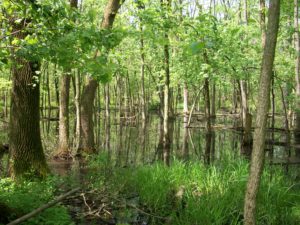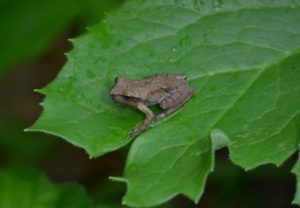 By LOGAN DUNN, park technician
By LOGAN DUNN, park technician
Listen … do you hear? Spring is near and wetlands are beginning to come alive! Wetlands are marvelous natural features, which serve many vital purposes throughout the year, from flood mitigation to wildlife habitat. But what about during the spring? As the season changes, we begin to hear the musical serenade of spring peepers, western chorus frogs, the American toad and others. Why do frogs need wetlands? Most wetland frogs have little tolerance for dry environments, due to their thin, porous skin. Water is extremely important to them − more than any other terrestrial species. Among other things, frogs require water for breeding, and the wetlands fill in the spring from snow melt and early seasonal rains.
 Salamanders, such as the spotted, Jefferson and small-mouth, also frequent wetlands for breeding in the spring. So the season is essential for maintaining the species and diversity of salamanders. Here’s a fun fact: salamanders can regenerate their tails and toes, if lost for some reason. This helps to protect them from predators.
Salamanders, such as the spotted, Jefferson and small-mouth, also frequent wetlands for breeding in the spring. So the season is essential for maintaining the species and diversity of salamanders. Here’s a fun fact: salamanders can regenerate their tails and toes, if lost for some reason. This helps to protect them from predators.
Spring also is a time for the rejuvenation of wetland vegetation. We begin to see shoots emerging from the wetlands, and surrounding trees begin to bud. Plants that grow in wetlands are called hydrophytes and are the basis of the food web. They provide a source of food for waterfowl, muskrats and beavers. Vegetation such as spike rush, soft-stem bulrush, pickerel weed and a plethora of other species are often found in a wetland. In addition to providing food, wetland plants provide cover and habitat for many species. Wetland plants can also filter out contaminants from the water and store them, helping to clean the water. Lastly, wetland plants help mitigate flooding by reducing the speed of water and slowly releasing it over time.
Get out and enjoy the wonders of wetlands and vernal pools this spring. You won’t be sorry!






